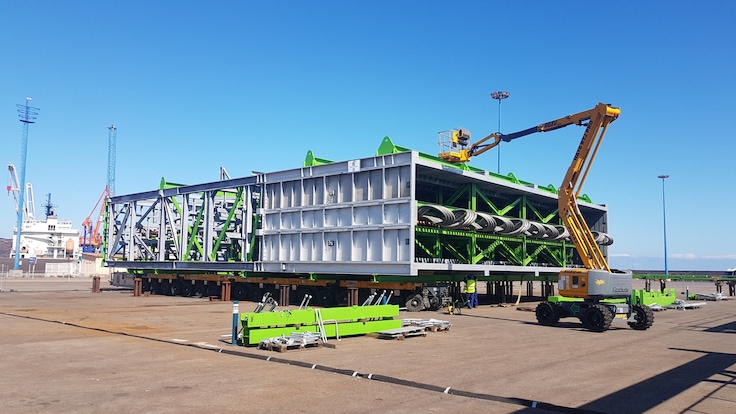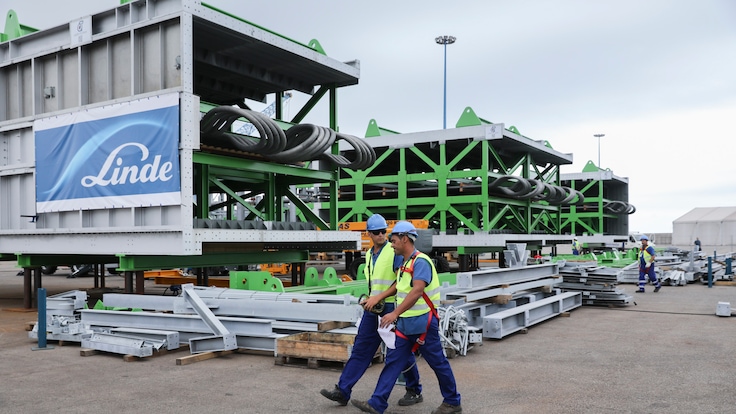Modularization Path to Success
Engineers at Selas-Linde have come up with a solution that allows them to deliver ethylene cracking furnaces to customers where on-site assembly would be too difficult or expensive.

The Linde experts pre-assemble the furnaces off site and ship the extremely heavy modules individually to the customer by ship and truck. The individual modules are then assembled on location.
Most children have played with LEGO at one stage or another. However, these colorful building blocks don’t just inspire little people. Engineers have long been using this perfect example of modularization for their own purposes. Specialists at Linde Engineering apply the same concept, building plants in modules at “remote module yards” before shipping them to their final destinations. The company even has a dedicated Competence Centre Modularization (CCM) that focuses on the various modularization challenges that arise in different projects. “In the past, process plants were typically stick-built. In other words, virtually every component that went into that plant was assembled on site,” explains Kay Funk, Director Sales & Execution at Selas-Linde. Headquartered in Pullach, Germany, and part of Linde Engineering, Selas-Linde is a global leader in industrial furnaces. “Today, we think more in terms of a LEGO building instructions. In other words, we initially build the different parts of an industrial furnace off site, sometimes in different locations. Then we ship all the elements to the construction site for final assembly.”

Splitting 2,000-Tons Industrial Furnaces into “Building Blocks”
Funk and his team are currently working on a project that shows how modularization can be the key to success. In the Spanish city of Gijon, the industrial furnace specialists are working with external partners to build the individual modules of an ethylene cracking furnace. At the beginning of 2020, these elements will then be shipped 1,500 kilometers to the remote shores of Scotland. When the industrial furnace has been fully assembled at the customer site and is ready to be commissioned, it will weigh around 2,000 tons – nearly equal in weight to 2,000 Volkswagen Golf cars, for instance. In theory, it would be possible to ship this industrial giant in one go to the customer. In reality, however, the local infrastructure would not be up to it. “We wanted to keep assembly work on site to a minimum and so we decided to pre-assemble 22 modules in Gijon and then send these off to Scotland,” adds Funk.

Unleashing the Benefits of Modularization
The individual elements of the furnace will first be transported by ship and then carried by road from the port in Scotland to their final destination. This means that the Linde experts have to build truckable modules that can be transported by heavy duty trucks. A modular design doesn’t mean that the elements of this LEGO project are lightweight. The heaviest modules weigh between 78 and 150 tons and are between 11 and 29 meters long. There is also another reason why the team at Selas-Linde opted for this modular approach. “We won’t be assembling the cracking furnace on a greenfield site. We’ll be working within a fully operational industrial complex,” explains Funk. Working on unused land is known as a greenfield project whereas an area such as an industrial complex is called a brownfield site. “The safety risks are greater with brownfield projects because there are already machines, pipes and reactors under operation in the direct neighborhood of the construction area. Some of these operate under high pressure and at high temperatures with highly flammable and in some cases toxic substances. Pre-assembling the plant modules reduces the amount of time spent on the construction site to a minimum, which, in turn, minimizes the risks for everyone involved.”
Are you interested in a quote?
Send an RFP
Yards: The Birthplace of Plant Modules
In the past, modularization often didn’t emerge as the strategy of choice until the engineers had reached the planning phase of a project. Today, Linde’s experts often have the concept on their radar from the very beginning. The company has now established a global network of huge facilities, known as yards, for pre-assembling modules. The yards can be used to build modules or even entire plants. Each location has an experienced team on site with equipment such as specialist cranes and gantries at the ready. Experienced employees, a familiar environment and minimal disruption from the weather – these are all factors that contribute to a project’s success. However, modular construction might not always be the best solution, as Funk explains: “Modularization means that every component has to be transported twice: from the manufacturer to the yard and from the yard to the customer – as part of a module. This last step can be challenging due to the size of the modules. In the case of stick-built plants, which are almost entirely assembled on the construction site, the different components only have to be shipped to the final destination. It’s the job of Linde’s experts to find the best solution for each project based on its specific requirements and context. In the case of this cracking furnace, Selas-Linde decided to carry out 60 to 65 percent of the assembly work at the yard in Gijon.
Meticulous Planning and a Reliable Team
“The biggest challenge for us and our external partners is drawing up a painfully precise timeline,” continues Funk. “Every component destined for the yards has to arrive on time and in top quality. In a stick-built project, it’s also a problem if components arrive behind schedule. But it’s easier to deal with any delays and, if necessary, continue building somewhere else.” In a modular project, logistics and timelines are even more important – and it’s vital that everyone involved knows what they are doing and how this impacts the entire project. “Everything has to run like clockwork,” elaborates Funk. “We have to be able to rely 100 percent on our suppliers and all of the external partners who are helping us with pre-assembly work at Gijon,” adds the Selas-Linde expert. Which is why the industrial furnace specialists make sure from the very outset that subcontractors can also meet the high quality standards and deadlines required for the project. In recent years, Selas-Linde has further refined its expediting activities to support technical procurement and has now established a global procurement network. The material for the cracking furnaces produced in Gijon is sourced from more than a dozen countries.
“Truckable modules are a cost-effective solution for areas that are difficult to access and have limited assembly resources.”
Success Built on Proven Expertise
“We worked on a similar project for the company Noretyl in Rafnes, Norway, clearly demonstrating that we have what it takes to successfully master modularization,” explains Funk. “This is an excellent reference project that strengthens our competitive position.” Modularization with truckable modules is the ideal choice for projects where assembly resources are scarce, where we are upgrading facilities during ongoing operations or where local infrastructure cannot handle the transportation of mega modules. “We have the perfect answer to brownfield challenges,” concludes Funk. The work in Gijon is currently running perfectly to schedule, ensuring that the modules will be ready for transport on time beginning January 2020.